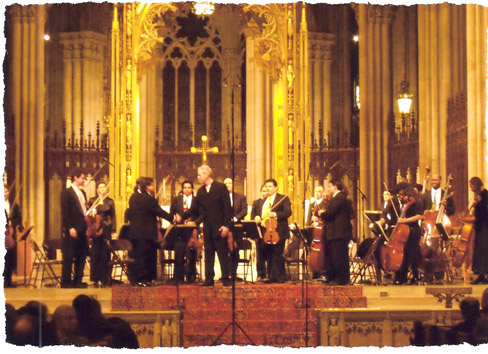Writing a review for an organization that one has physical ties to can be quite challenging. [Mr. Sean appeared in performance with Musica de Camara on February 18, 2014- Editor’s note] This is not the case here. Eva de La O, founder and director of Musica de Camara, presented a group of musicians tonight that would make even the most discerning listener’s job difficult. This concert, under the direction of Maestro Roselin Pabón, was like a mosaic ribbon attached to thirty-four years of continuous gift-giving. To see and hear such youthful vibrancy tied together with professionalism of the highest order, I can think of no better way to say ‘thank you’ than a program of newly premiered works by talented young composers.
The featured soloist for the evening, Christian Colberg, performed a single movement from his Viola Concerto. Mr. Colberg offered the first movement, entitled Alonso, which depicts a scene from Cervantes’s novel Don Quixote as Alonso Quixano styles himself Don Quixote. Mr. Colberg’s impeccable intonation and clarity of sound allowed me to focus on the structure of the piece, which would have not been possible if the soloist were not of his caliber. This is a Twenty-First-Century work unmistakably written in the great Nineteenth-Century Romantic tradition, with broad, recurring themes, and fiendishly difficult passages. Mr. Colberg masterfully eschews that tradition at the climax and culmination of the piece by ending with a non-traditional cadence. It reminded me of a bullfighter tossing his sword to the ground and kneeling in triumph at the end of a long and bloody match.
Another composer/performer of note is principal bassist Pedro Giraudo (b. 1977). His Suite for String Orchestra, which was commissioned by Musica de Camara, is a delightful work written by a jazz master, who also is a fine classical player as well (reminiscent of the Argentine tango master Astor Piazzolla). Solos were tossed from section leader to section leader with the highest sophistication and skill. Diego Sanchez Haase’s (b. 1970) Sonata Paraguaya, which was premiered in the U.S. this concert, was a gift to Musica de Camara by the composer. While listening, it occurred to me that the nationality of each composer was integral to their compositions. Whether this was planned or not, it made for an interesting mix of sounds and rhythms from near and far. Dominican composer Angel Herdz (b. 1968) in his Serenata para Arcos, Op. 4, presented a work that was not as easy to place geographically, but the jagged lines in the third movement served as a nice diversion from the slowness of the piece. The youngest composer, Jessie Montgomery (b. 1981), favored the audience with her work for strings entitled Strum. This thirty-three-year-old violinist of the highly acclaimed Catalyst Quartet is one to watch, as she is a composer of film, theater, and concert music-a triple threat talent! Ironically, the oldest work on tonight’s program, Tiepmo Sereno, by Hector Campos Parsi (1922-1998), sounded the most modern to my ears. This work uses alternating major/minor modes, and repetitious phrases that build from nothing until they seem to nag at your soul. He paints a picture of stars and galaxies, and of our ability to visit such places in the very distant future.
Finally, how does one take a program of new music and in three days give a performance worthy of any stage in the world? You give it to Maestro Pabón. Here is a master who understands rhythm so well that it never becomes a distraction. I can tell he does his homework-nothing is left to chance, even though he has first-rate soloists under his baton. Maestro Pabón’s unspoken insight (he doesn’t speak much during rehearsals) landed on the ear of every listener that night. It is no small feat holding together an entire program of unfamiliar and difficult works. As I greeted the conductor backstage several moments after the concert, I couldn’t help but notice that he was the only one still perspiring.
As Musica de Camara brings thirty-four seasons of wonderful music making to a close, I look forward to the start of a new season, and that year thirty-five will be as generously rewarding as what I witnessed tonight.


